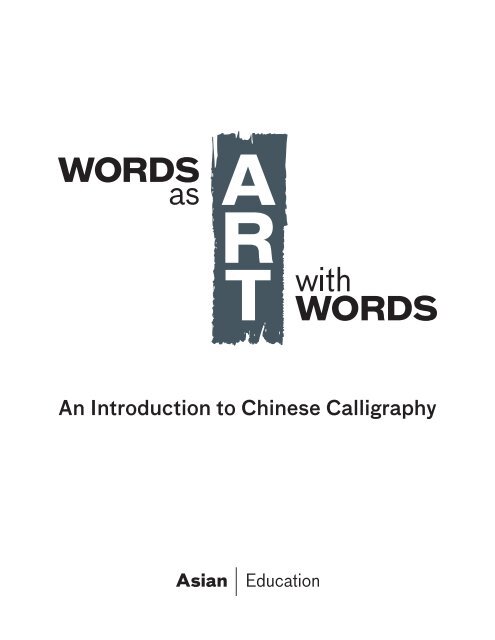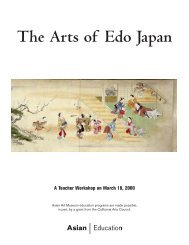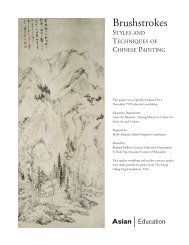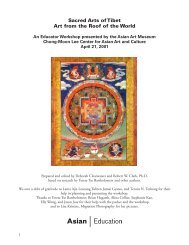Chinese Calligraphy (.pdf) - Asian Art Museum | Education
Chinese Calligraphy (.pdf) - Asian Art Museum | Education
Chinese Calligraphy (.pdf) - Asian Art Museum | Education
Create successful ePaper yourself
Turn your PDF publications into a flip-book with our unique Google optimized e-Paper software.
An Introduction to <strong>Chinese</strong> <strong>Calligraphy</strong>
Lead funding for the <strong>Asian</strong> <strong>Art</strong> <strong>Museum</strong>’s <strong>Education</strong> and Public Programs is provided by Bank of America Foundation.<br />
Major support provided by Douglas A. Tilden, The Japan Foundation Center for Global Partnership, The Henri & Tomoye Takahashi<br />
Charitable Foundation, Koret Foundation, Freeman Foundation, Atsuhiko and Ina Goodwin Tateuchi Foundation, PARSA Community<br />
Foundation, Sugiyama Family Trust, Konigsberg Family Trust, Walter and Elise Haas Fund, and AT&T.<br />
Additional support provided by the William Randolph Hearst Foundation, Mary M. Tanenbaum Fund of The San Francisco Foundation,<br />
The San Francisco Foundation--Shenson Foundation, the Robert H. N. Ho Family Foundation, and Joseph R. McMicking Foundation.<br />
<strong>Asian</strong> <strong>Art</strong> <strong>Museum</strong><br />
Chong-Moon Lee Center<br />
for <strong>Asian</strong> <strong>Art</strong> & Culture<br />
www.asianart.org<br />
200 Larkin Street<br />
San Francisco, CA 94102<br />
T 415.581.3500<br />
F 415.581.4700<br />
<strong>Asian</strong> <strong>Art</strong> <strong>Museum</strong> <strong>Education</strong> Department 2
Words as <strong>Art</strong>: An Introduction to <strong>Chinese</strong> <strong>Calligraphy</strong><br />
How do you integrate words and art to express an idea? China’s educated elite painted<br />
artful writing, more commonly known as calligraphy, since at least the Han dynasty (206<br />
BCE–220 CE). <strong>Chinese</strong> calligraphy is a visual art. The fluid strokes, dots and lines that<br />
form each character are its focus. The content of a calligraphic work, while sometimes<br />
inspiring or moving, is usually nothing new. What is fresh, exciting, and creative is the<br />
way it is visually expressed.<br />
In China, painting and writing developed hand in hand, sharing the same tools and<br />
techniques. <strong>Chinese</strong> writing is composed of block-like symbols which stand for ideas.<br />
Sometimes called ideograms, the symbols more often are referred to as characters.<br />
These characters, which evolved from pictograms (simplified images of the objects they<br />
represent), were modified over time to represent more abstract concepts.<br />
Basic Strokes<br />
The character yong (which means eternity) contains eight strokes and dots that beginning<br />
calligraphy students learn as the basis for many other strokes.<br />
<strong>Asian</strong> <strong>Art</strong> <strong>Museum</strong> <strong>Education</strong> Department 3
Fragment of oracle bone, approx. 1300-1050. China; Henan province. Shang dynasty (1600-1050 BCE). Probably cattle<br />
bone. The Avery Brundage Collection, B60M502.<br />
Early Writing in Ancient China: Oracle Bones<br />
The earliest <strong>Chinese</strong> writing that historians have found is on Shang dynasty<br />
(1600-1050 BCD) oracle bones. Oracle bones were used to divine answers<br />
to various questions such as the success of a particular harvest, the fate of future<br />
military expeditions, and very personal matters such as what to do about a toothache.<br />
The questions, answers and outcomes were all recorded on cattle bones<br />
and tortoise shells. A metal rod, or perhaps a burning ember was heated<br />
and placed on the bone near where the question had been written. The shape<br />
of the crack determined the answer, and the outcome (what followed) was<br />
sometimes written on the bone.<br />
This oracle bone says: “The Gongfang will not go on a great campaign [against<br />
us]. We should order “Attack the Gong[fang].” We should not order “Attack the<br />
Gongfang.” On the next jiaxu [day] it will perhaps rain.<br />
What questions or outcomes would you write on an oracle bone today?<br />
<strong>Asian</strong> <strong>Art</strong> <strong>Museum</strong> <strong>Education</strong> Department 4
Scripts<br />
Five basic scripts have emerged over 2000 years: Calligraphers design each character<br />
to fit into an imaginary square–whether it is composed of one or sixty-four strokes.<br />
Writers must create each stroke of a character in a particular order, essentially from left<br />
to right and from top to bottom.<br />
The evolution of the <strong>Chinese</strong> character dragon (long) in various script types:<br />
Oracle-bone Seal Clerical<br />
Cursive Semi-cursive Standard<br />
There are five basic scripts regularly used in <strong>Chinese</strong> calligraphy:<br />
Seal script (<strong>Chinese</strong>: zhuanshu)<br />
These careful, straight lines are related to the earliest forms of <strong>Chinese</strong> writing.<br />
Clerical script (lishu)<br />
More angled strokes allowed clerks to write official documents more easily and quickly.<br />
Standard or regular script (kaishu)<br />
This clear and easy to read script is commonly used in printed books and signs today.<br />
Semi-cursive script (xingshu; “running script”)<br />
Strokes tend to run together within each character, but the artist usually lifts the brush<br />
between each character.<br />
Cursive script (caoshu; “grass script”)<br />
In this free and spontaneous script, artists may get away with abbreviating and abstracting<br />
the characters. Characters may run together.<br />
<strong>Asian</strong> <strong>Art</strong> <strong>Museum</strong> <strong>Education</strong> Department 5
Tools and Materials: The Four Treasures<br />
The Four Treasures are the most essential implements for any painter or calligrapher.<br />
They are the brush, paper, the ink stick, and the ink stone,<br />
The Brush<br />
The brush is very flexible and versatile. It comes to a fine point so that it can produce<br />
very thin lines, but it is also fat enough to make wider lines and dots. To make a brush<br />
tip, one or several kinds of animal hair may be used including rabbit, wolf, goat, badger,<br />
and even the whiskers of mice. Brushes vary in size from tiny, fairly stiff wolf hair brushes<br />
for outlining to immense resilient brushes for large calligraphic scrolls. Long tapering<br />
brushes are good for swirling movements; short stumpy ones produce a blunt line with<br />
the understated impression favored by some of the scholar painters.<br />
The Paper (or silk)<br />
The next important material, paper, was invented in China during the Western Han<br />
dynasty (206 BCE–CE 9). Early calligraphers carved records in stone, cast them<br />
in bronze, or wrote them on bamboo strips or silk, but all of these materials were too<br />
expensive or too big and bulky. It was not until the Tang dynasty (618–906) that painters<br />
began to use paper on occasion, and it was not used extensively for pictures until the<br />
Yuan dynasty (1279–1368). (In fact, most early painting had been done on silk.) At first,<br />
calligraphers and painters made paper from rags. Eventually they used various kinds of<br />
vegetable fiber, including tree bark, grass, hemp, and grain husk.<br />
The Ink Stick<br />
Black ink was made from soot mixed with glue and formed into hard sticks. The finely<br />
ground soot produces the color while the glue both holds the stick together and acts as<br />
an adhesive to bind the ink to the paper or silk. Pine soot, from the inner wood of the<br />
tree, produced the best all-around ink, but other kinds of soot and various animal glues<br />
have been used. Ink compounders have experimented over the ages with different materials,<br />
sometimes adding such unlikely ingredients as powdered pearls and jade dust. Most<br />
ink makers guarded their recipes carefully, never writing them down and passing them on<br />
only to their apprentices. Therefore, the recipes for making some special ink have been<br />
lost such as that for a once-popular bluish ink.<br />
The Ink Stone<br />
To use the ink stick, painters must grind it with water on a fine-grained stone. The ink<br />
stone became one of the Four Treasures of the scholar. The quality of the stone’s grain<br />
was of the greatest importance, but stones were treasured also for their color and<br />
beauty. They were cut and carved so that they had a flat surface for grinding.<br />
<strong>Asian</strong> <strong>Art</strong> <strong>Museum</strong> <strong>Education</strong> Department 6
Formats<br />
<strong>Calligraphy</strong> is often painted either on paper or silk; each respond to ink and brush<br />
differently. The most common formats for calligraphy are: Fans, albums, hanging scrolls,<br />
and handscrolls.<br />
Scrolls are sheets of paper that could be rolled, covered in silk, and stored away.<br />
Owners added additional sheets of paper over time, so that scrolls could grow to up to<br />
10 meters (about 20 feet) in length. Handscrolls are read and enjoyed section by<br />
section, so it was unusual for a handscroll to be unrolled in its entirety.<br />
<strong>Asian</strong> <strong>Art</strong> <strong>Museum</strong> <strong>Education</strong> Department 7
Holding the Brush<br />
1. Hold the brush midway up the handle.<br />
2. Grip the brush like a pen, but leave an open space in the palm of your hand,<br />
3. Hold the brush in a gentle and relaxed manner. Imagine holding a tomato without<br />
bruising its skin.<br />
4. Hold the brush at a 90-degree angle, perpendicular with your paper.<br />
<strong>Asian</strong> <strong>Art</strong> <strong>Museum</strong> <strong>Education</strong> Department 8
Poetry<br />
The most common subject matter in calligraphy is poetry. <strong>Art</strong>ists either recreate classic<br />
works or, occasionally, compose their own. A particular poem might reflect political dissent,<br />
disappointment in life, or the joys of retirement.<br />
This album of calligraphy attributed to artist Mi Fu, recalls a 300-year old poem<br />
about the Duojing lou, a famous spot in Jiangsu province known for having some of the<br />
most beautiful views in the world. Later collectors and viewers added three colophons<br />
and 193 seal impressions.<br />
Poem concerning the Pavilion with Various Views (Duojing lou), in semicursive script (xingshu), attributed to Mi Fu. <strong>Chinese</strong>, 1051-<br />
1107. Northern Song dynasty, approx. 1071-1107. Album with 11 pages and 3 pages of comments, ink on paper. <strong>Asian</strong> <strong>Art</strong> <strong>Museum</strong>, The<br />
Yeh Family Collection, 2004.31.<br />
<strong>Asian</strong> <strong>Art</strong> <strong>Museum</strong> <strong>Education</strong> Department 9
<strong>Art</strong>ist in Focus: Xu Bing<br />
Xu Bing is renowned for his artistic explorations of the role of<br />
language in human life. He was 11 years old when Mao launched<br />
the Cultural Revolution. Throughout most of his childhood he witnessed<br />
firsthand the written word’s power to manipulate masses.<br />
In much of his work, he draws on the calligraphic principle<br />
of using words as art. In installations such as Book from the Sky<br />
(1987), Xu covers scrolls with an invented language (that appears<br />
real). In Square Word <strong>Calligraphy</strong> (2004), he blends the English<br />
alphabet with principles of writing <strong>Chinese</strong> calligraphy to create a<br />
visual hybrid.<br />
In The Character of Characters, Xu Bing draws parallels between the repetitive,<br />
rigorous practice of calligraphy and aspects of <strong>Chinese</strong> culture, both contemporary and<br />
historical. You’ll see images of the construction of the Great Wall, of mass production in<br />
<strong>Chinese</strong> factories, and of marchers in ordered rows at the Beijing Olympics and in military<br />
ceremonies.<br />
It touches on such varied subjects as<br />
• the genesis of writing,<br />
• the connection between <strong>Chinese</strong> calligraphy and painting,<br />
• the role of copying in art and society, and the trust native <strong>Chinese</strong> readers place in<br />
symbols—including the current <strong>Chinese</strong> love affair with name-brand luxury goods.<br />
The Character of Characters, 2012, by Xu Bing (<strong>Chinese</strong>, born 1955). Five-channel video animation installation. Acquisition made<br />
possible by The Robert H. N. Ho Family Foundation, R2012.54<br />
<strong>Asian</strong> <strong>Art</strong> <strong>Museum</strong> <strong>Education</strong> Department 10
Square Word <strong>Calligraphy</strong> Alphabet<br />
adapted from Square Word <strong>Calligraphy</strong> by Xu Bing<br />
www.xubing.com<br />
<strong>Asian</strong> <strong>Art</strong> <strong>Museum</strong> <strong>Education</strong> Department 11
Activity: Peaceful Poetry<br />
1. Explore your school, home, or community to find a peaceful place where you can<br />
escape from the stresses of your daily life. Sketch or photograph this place.<br />
2. Sit quietly for 1 minute, observing your environment.<br />
3. Create your poem.<br />
a. Write three nouns to describe what you see.<br />
b. Write a phrase or sentence to describe what you hear.<br />
c. Write three adjectives to describe what you see or feel.<br />
4. Create an album leaf, fan, or scroll of your peaceful place and poetry. This can be as<br />
an ink painting, collage, performance, or any other art form.<br />
5. Share your Peaceful Poetry.<br />
6. Optional: Exchange with a partner and add a comment to your classmate’s artwork.<br />
Activity: Connecting Your Narrative<br />
1. To create your storyboard, use one strip of 4” x 17” receipt paper, or prepare long<br />
strips by cutting legal or ledger paper in half. Divide your strip of paper into 5 cells.<br />
2. Watch an excerpt of The Character of Characters, 2012, by Xu Bing at education.<br />
asianart.org.<br />
a. Sketch a storyboard of 3 cells recalling one sequence that you observed from<br />
The Character of Characters. Leave the last cell blank.<br />
b. What did this sequence remind you of in your own life? Design your 4th cell to<br />
add this connection to your storyboard sequence.<br />
c. Design your 5th cell by making a connection between your 4th cell and either the<br />
past or the future.<br />
3. Sign your name using the principles of Xu Bing’s Square Word <strong>Calligraphy</strong>.<br />
a. Paint a square. Use Holding the Brush as a reference.<br />
b. Inside the square, going from top to bottom and left to right, paint the letters in<br />
your name in any size and orientation. See: Square Word <strong>Calligraphy</strong> Alphabet.<br />
4. Share your completed narrative during a gallery or classroom discussion.<br />
Be prepared to explain your connections.<br />
For more examples and lessons of Words as <strong>Art</strong> throughout Asia, visit<br />
education.asianart.org.<br />
<strong>Asian</strong> <strong>Art</strong> <strong>Museum</strong> <strong>Education</strong> Department 12
















